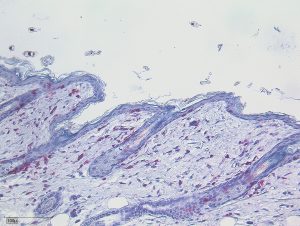
Jasper van den Boorn
For a very long period of time scientists focused on the adaptive immune system when looking for evidence of cells reacting towards a certain molecule or another specific stimulus. Today it is common knowledge that the adaptive immune system generates long-lived memory T cells that protect us from viral infection, the spread of mutated cells and invading pathogens. In contrast, Natural Killer (NK) cells were considered to recognize stressed cells and form the first line of defense by rapidly responding to foreign molecules, pathogens and tumor formation. Furthermore, due to their innate immune origin and the assumption to be short-lived, they were expected to react unspecifically. However, Dr. Jasper van den Boorn, a scientist at the ImmunoSensation Cluster of Excellence, and colleagues now published a paper in the highly ranked journal “Immunity“, establishing the “Inflammasome-Dependent Induction of Adaptive NK Cell Memory“.
Since his PhD Jasper has had a particular interest in pigmenting disorders and soon began to focus on the effects the application of monobenzone has on the immune system.
Within the past years of his research Jasper showed that this substance is able to activate immune cells and induce the autoimmune disease vitiligo vulgaris. Furthermore, he showed that monobenzone can instruct immune cells to specifically attack pigmented cells, a feature that qualifies monobenzone application as a promising melanoma immunotherapy approach. As a result of his findings during his PhD in The Netherlands, Jasper was recruited to become a postdoc at the University Hospital in Bonn in 2011, recently became a group leader at the Institute of Clinical Chemistry and Clinical Pharmacology and is eager to present his research and exciting novel findings.
Jasper, congratulations for your amazing new paper!
You have worked with monobenzone for several years now. How did this substance attract your attention in the first place?
“Since my master thesis I was interested in the interplay between vitiligo and melanoma as two diseases that lead to exactly contrary cell fates. While vitiligo induces the destruction of pigmented cells, melanoma is characterized by the uncontrolled proliferation of those. My fascination was first fueled when I had the opportunity to intern at the National Cancer Institute of Amsterdam where I worked on a T cell therapy for melanoma. During my PhD I then concentrated on vitiligo autoimmunity. In the course of my studies my workgroup and I established that vitiligo is indeed a T cell-driven autoimmune disease. Interestingly, we observed that melanoma patients who receive immunotherapy often develop a vitiligo-like depigmentation that is associated with a better survival of these patients. Thus, we asked whether the deliberate induction of vitiligo in patients would facilitate their survival. To this end, the potent skin contact sensitizer monobenzone was a great tool.”
As you described in previous publications, monobenzone application on the skin specifically induces the destruction of pigmented cells. How does this work?
“The substance monobenzone is a skin contact-sensitizing agent with a very fascinating working mechanism. Its intriguing feature and advantage as a research tool is that monobenzone itself is inactive and its active form is exclusively generated in pigmented cells.
When applied to the skin this small lipophillic molecule diffuses into the skin. If it enters melanocytes or melanoma cells that contain the melanosome, monobenzone is activated by tyrosinase, a key enzyme in the pigment synthesis cascade, which under normal circumstances ensures the complexion of your skin.
We found out that monobenzone is an alternative substrate for tyrosinase and is thus activated after melanosome entry. Monobenzone then immediately haptenizes tyrosinase as well as other melanosomal proteins and inactivates the tyrosinase. Conclusively, monobenzone specificity is caused by the fact that only tyrosinase can efficiently transform this molecule into its active form.
Monobenzone conversion and tyrosinase inhibition have several effects on the pigmented cell. First, the pigment synthesis cascade is inhibited which causes oxidative stress since precursor substances for melanin pile up in the melanosome. Second, due to the induced oxidative stress pigmented cells start to autophagocytically digest melanosomes to get rid of those damaged organelles. Third, the cells release exosomes containing pigment cell antigens and neo-antigens, formed by the tyrosinase-attached monobenzone hapten. These neo-antigens can be recognized by T cells, lead to a potent T cell response and the elimination of these damaged pigmented cells. As we recently discovered, a specific NK cell driven immune response likely occurs even before the T cell response is induced.“
Which cell types are involved in this process?

NK cells are activated by macrophages from the skin (image: J. van den Boorn)
“Interestingly, most contact sensitizers investigated so far stimulate dendritic cells or Langerhans cells in the epidermis. These cells then travel to the lymph nodes where they induce T and B cell responses. This mechanism was what we expected to observe, too. Surprisingly, in the context of our contact hypersensitivity model neither dendritic nor Langerhans cells were recruited to the lymph nodes and thus do not seem to play an important role in this immune response.
Histology stains showed that after monobenzone skin sensitization there are many macrophages migrating into the skin and indeed they home to the lymph nodes where they activate the NK cells in the very early phases of this contact hypersensitivity response. Thus, the cells driving this immune response are NK cells that are activated by skin-residing macrophages.”
So, how did you discover the formation of an adaptive NK cell memory?
“The discovery of adaptive NK cell memory formation actually resulted from my curiosity to investigate the incipient events at the root of monobenzone-induced immunity. In the studies we published a few years back, for melanoma immunotherapy monobenzone was applied with the immune adjuvants cytosine-guanine oligodeoxynucleotides (CpG) and imiquimod to maximize a strong T cell response. We were surprised to observe that if monobenzone was applied to the skin without additional adjuvants it still induced a considerable immune response that was not only driven by T cells. In Bonn, I mainly focused on monobenzone’s initial immune activating events in the contact hypersensitivity model and discovered that the compound itself selectively induced an NK cell mediated immune response in wild type mice that resulted in the destruction of pigmented cells. This was thrilling since up to then all known memory NK cell responses were mostly directed at “non-self” targets.
Importantly, for our recent publication the combined expertise of the research teams in Bonn was crucial. In our recent publication Prof. Hartmann, Prof. Hornung and I together state that the NLRP3 inflammasome in skin tissue-resident macrophages is essential for the formation of an adaptive NK cell memory.“
Which future applications may your recent discoveries have?
“There are three main benefits I would like to point to:
- We discovered tissue specific cytotoxic memory NK cells which can be primed to attack pigmented cells and also prevent tumor outgrowth. This knowledge will hopefully be used to optimize melanoma immunotherapy.
- It still is a burning question how certain autoimmune diseases are initially triggered. We now discovered a mechanism that may lie at the basis of certain autoimmune processes, like the development of vitiligo.
- We identified memory NK cells, which are specifically directed against a self-tissue. Now we hope our discoveries will help to characterize other memory NK cell responses in the future.“
In the long run the reported inflammasome-dependent adaptive NK cell memory is well in line with some recent publications addressing memory development by innate lymphoid cells. Hopefully, these novel findings will contribute to a better understanding and characterization of similar immune cell memory responses, push the boundaries of our knowledge on innate lymphoid cell biology and finally provide some innovative approaches to combat diseases like melanoma.

Author: Larissa Mühlenbeck
